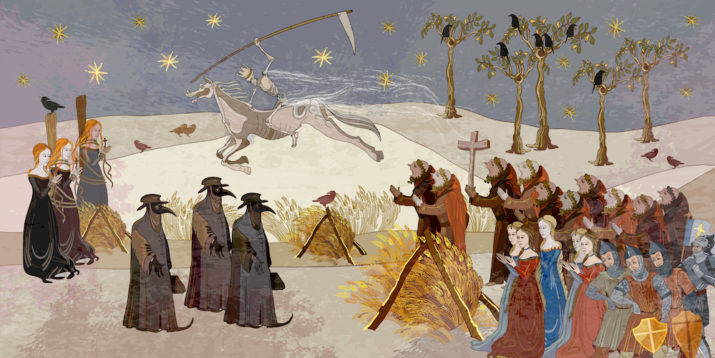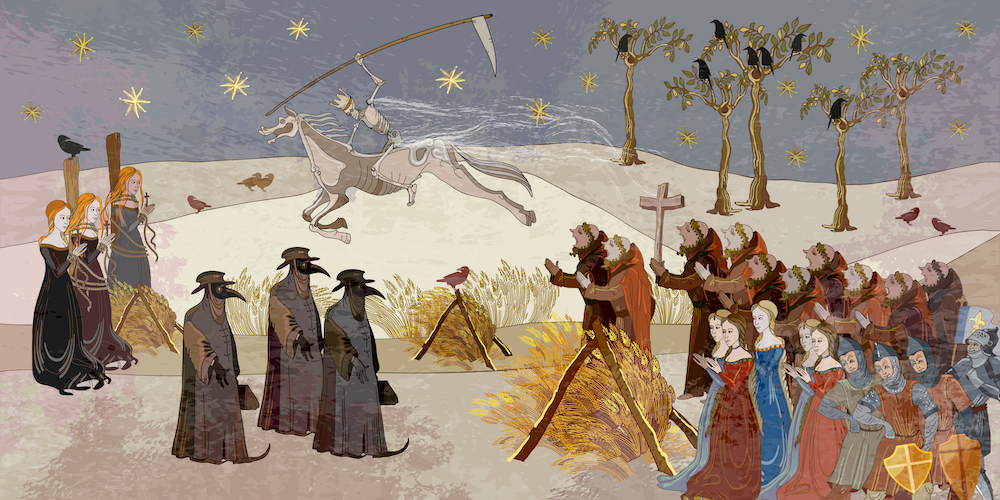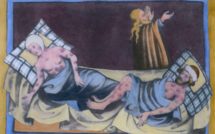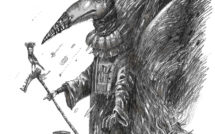

This is part of our Campus roundtable on Teaching Medieval in Modern Plague Times.
The pandemic had disastrous effects on New Jersey, a state hit hard early on in the crisis. Saint Peter’s University is a small, tight-knit Jesuit university in Jersey City, the second-most diverse city in the United States, catering to a demographic of mostly students of color. Saint Peter’s closed its dorms to all but those students who could demonstrate they had nowhere else to go (such as those from countries to which they were not able to travel due to the pandemic), and shifted to online learning in mid-March 2020. Our students, many of whom were still working and would continue to do so throughout the crisis, had to move back to their urban, often multigenerational households, sharing electronic devices with parents and siblings, dealing with weak or no Wi-Fi, broken laptops, and health crises.
In Spring 2020, I was in only my first year of teaching at Saint Peter’s University, teaching four courses in the history department: three sections of the Western Tradition, the history survey course that all of our students are required to take, and one section of a class I created, Secret Lives of Ancient Women, an upper-level course for history majors. History is not the most popular major at our university, at least measured in terms of sheer numbers of majors. However, the events of Spring 2020 revealed that some of our students have an interest in medieval European history, and the public health crisis we faced as a community sent our students looking back to the medieval past for insights, comparisons, and lessons for our world. Unsurprisingly, my role as an educator shifted in response to our new reality.
In this essay, I focus mostly on my experiences teaching Western Tradition, as my three sections of approximately thirty students each reached nearly one hundred students altogether. The Western Tradition course is well-known at Saint Peter’s, both because all students have to take it and what it covers: the foundations of Western history, from the ancient world until the Enlightenment. It is enormous in scope and in geography, and most of the course material is unfamiliar to most undergraduates; I joke every time I teach this class, “As soon as we get to a time period anyone has heard of, poof, the semester is over.” But normally we plow on, and students come away knowing far more than they did at the semester’s start. Spring 2020, however, was not going to be business as usual. As we moved to remote learning, I readjusted my objectives and eventually landed on two goals. The first was to be “kind, flexible, understanding, and adaptable,” as the provost at our university wisely urged faculty to be. The second goal was to still provide my students something valuable to take with them after our difficult semester came to an end.
I had already decided that I would not be teaching the about the medieval Black Death in my Western Tradition course. I need to back up here and give a little background behind this choice. Because of the enormous geographical and chronological scope of the Western Tradition course, every instructor who teaches it has to make difficult choices about what to focus on and what to cut out—it is impossible to introduce all of premodern Western history in just fourteen weeks. Additionally, as a female historian of color teaching at an institution with a diverse population of students, I think it is necessary to devote time to breaking down and questioning the entire concept of the “West.” We explore questions such as “What and where is the ‘West’?,” “Why is this the subject of our required, beginning survey course in history?,” and “Who decides what is important for students to learn, and why?” In short, it is a lot, and we cannot do everything. I had decided, long before the pandemic and before anyone (including me) had even heard of COVID-19, not to teach a section on the Black Death. Back then, it was an uncontroversial decision. But all of that was soon to change.
I always want the students in my history courses to leave with improved skills, both in the evaluation of sources and clear and effective writing, two of the historian’s tools that are useful to anyone in any profession. For this reason, I decided to still require my students to write the final paper that I had originally included in the syllabus. This essay, meant to be three to five pages long and requiring the students to do some research, allowed the students, with my guidance and approval, to choose their own topics. This can be a lot of responsibility for undergraduates, particularly first-year students and any others for whom the course material is new and unfamiliar. But giving the students that choice often makes for livelier and more interesting papers—both for them to write and for me to read. During the public health crisis last semester, many of my students chose to write about the outbreak of the Black Death in the medieval world.
Suddenly, in the face of a global health crisis of our own, students who had vaguely heard of the Black Death (perhaps in high-school history courses or in the online think pieces currently circulating, comparing and contrasting the two pandemics) began making references to it, in their homework assignments, on our discussion boards, and of course in their final essays. They made comparisons and drew links to our contemporary situation. They wrote about how some of our tools for stopping the spread of COVID-19—quarantine, social distancing—had also been used to stop the spread of the Black Death in medieval Europe. They came to the unfortunate realization that a globalized world helps spread infectious diseases to the point that they become pandemics. I always teach that we are not the first globalized era in history—there is robust evidence for a globalized, interconnected world going back to the Mesopotamian civilizations of the Bronze Age, of people traveling great distances, living far from their original homelands, intermarrying, learning each other’s languages. Tragically, not only goods, ideas, and human beings travel in a globalized world, but diseases do too. We all came to know that last spring, and my students recognized and learned about it as a historical phenomenon as well, without any nudges from me. Without being prompted, they were behaving like historians, and I was impressed. Watching this happen in my (digital) classroom made me think about what a historian is. The mechanics of the historian involve the gathering, analysis, evaluation, and synthesis of sources. But on a human level, this means that historians are the keepers of memory. Historians can see into the past, which helps us all see into the present as well as the future.
I responded to students’ questions and comments about the Black Death when they raised them and helped those who had chosen to write about it for their final essay. Nevertheless, I remained wary of deliberately introducing too much course content related to either the current pandemic or past pandemics, or of transforming our class into a “historical processing session” for the pandemic. I know that other history teachers felt differently about this and took different approaches to dealing with the crisis in their classrooms—especially those who perhaps have more experience with teaching the present as history; it is rare that anything I teach as a premodern historian takes on the kind of contemporary relevance that the medieval Black Death did this past year. And I know that, last semester, we were, as many in the media like to say, “living through history” like never before.
But I learned something about the notion of “living through history” last spring, not as a premodern historian but as a human being. And that is that, during times like these, we may not feel as though we are doing anything so lofty as “living through history”—we may feel like we are simply surviving. I read numerous Facebook think pieces reminding me that we were not simply “working from home,” but rather wading our way through a frightening global pandemic and trying to get some work done. I also did not know if examining our pandemic as a historical moment, or learning about other pandemics in history, would be appropriate, compassionate, or welcome for any of my students trying to survive in particularly difficult circumstances. I was very fortunate throughout this crisis. I never became ill. No one in my immediate family or circle of friends contracted the virus. I was privileged enough not to lose my job as millions of others did. I was privileged enough not to have to put myself and my family at risk by working an essential job. I kept my job, worked from home, and did not experience significant financial worries. This was not the case for many of my students, who did experience illness and deaths in their families, and who did work essential jobs that required them to leave their homes at a time when that was an increasingly scary thing to do. So, I did not want to require them to think about the pandemic, or the idea of a pandemic, any more than they already had to.
I did, however, on our final exam, offer an invitation for students to reflect on the historical meaning of the pandemic for us. Saint Peter’s, after all, is a Jesuit institution rooted in the principles of Ignatian pedagogy. The Ignatian Pedagogical Paradigm includes five steps in the learning process: context (which means that we, as we say at SPU, “teach the students we have in front of us,” taking into consideration their life circumstances, life experiences, and identities); experience (which considers how what students learn is shaped by what they know—a notion that became all too real for us in Spring 2020); reflection (which I’ll discuss below); action (for us at SPU, this tenet often manifests as the desire to give back to the community, achieved by our numerous service learning courses that incorporate an element of volunteering or service to the community); and evaluation (how we assess students’ progress, which, hopefully, goes beyond the rote assigning of grades). At SPU, faculty are encouraged to think about which of the five steps of the paradigm our class assignments touch upon. Here is the optional prompt I offered on the final exam, encouraging the students to use personal reflection to enhance their academic learning:
- Historians in the future are going to remember the year 2020 forever. What will historians in the future want to know about this year? What sources will they use to gather their information? Will their sources be trustworthy and reliable or unreliable? Will they understand the whole picture? Will any parts of the story remain a mystery to them? Why?
- If you could tell the historians of the future one true thing about our lived experience in March-May 2020, what would you tell them? Understand that we are living through history right now; we are the ones who get to tell this story. So, tell it.
I was uncertain about this prompt, and uncertain about what sort of response it would elicit. Most of my students did choose to respond to the prompt. And I was both touched and blown away by their thoughtful, insightful, and compassionate responses, in which they considered the impact of COVID-19 not only on themselves and their families, but also on society as a whole, our education system, the economy, and planet Earth. Their responses solidified my belief that Generation Z, to which most of our students belong, is a wonderful, caring generation. I am hopeful for the future.
In Fall 2020, Saint Peter’s went fully online, except for some courses that require in-person instruction, such as labs, clinical training, and studio-based courses. My schedule of classes had been set long before we knew what Fall 2020 was going to look like. I taught four sections of a new survey course, “History of Ancient Science,” which I developed in my capacity as a historian of science whose research focuses on Greco-Arabic studies. It is a difficult course—the readings are challenging (as anyone who has read Aristotle’s Parts of Animals or Lucretius’ On the Nature of Things can attest), and it requires a lot of student participation, which is tough to do in an online setting. But things were different in Fall 2020. We all became Zoom experts and more proficient in online pedagogy, thanks in large part to our university’s numerous faculty training opportunities over the summer. We have had time to reflect and to prepare, a luxury we simply did not have last spring. In many ways, things were better.
But challenges remain. Saint Peter’s dorms are open this semester, as is the library, with limited hours. This alleviates some of our students’ issues of accessing technology that were problems in the spring. Even so, our students still struggle to get their hands-on working laptops, to log on to the school’s strained Wi-Fi network, to find safe, private spaces in which to attend their digital classes, and to schedule their remote courses and in-person labs around their work and family schedules. It already has been and will continue to be a difficult semester. But we forge on. The events of the COVID-19 pandemic and their effects on education gave me and my students the opportunity to reflect on the medieval past, to learn from where we have been and look ahead to where we are going—which is what historians do.
Maria Americo received her PhD from the Institute for the Study of the Ancient World at New York University, where she focused on ancient and medieval science, particularly the adaptation of Greco-Roman science in the medieval Islamicate world. She is currently assistant professor of history at Saint Peter’s University in Jersey City, NJ.
Photo: Middle Ages parchment style. World pestilence. Ancient book illustration | Shutterstock
Published on December 8, 2020.




